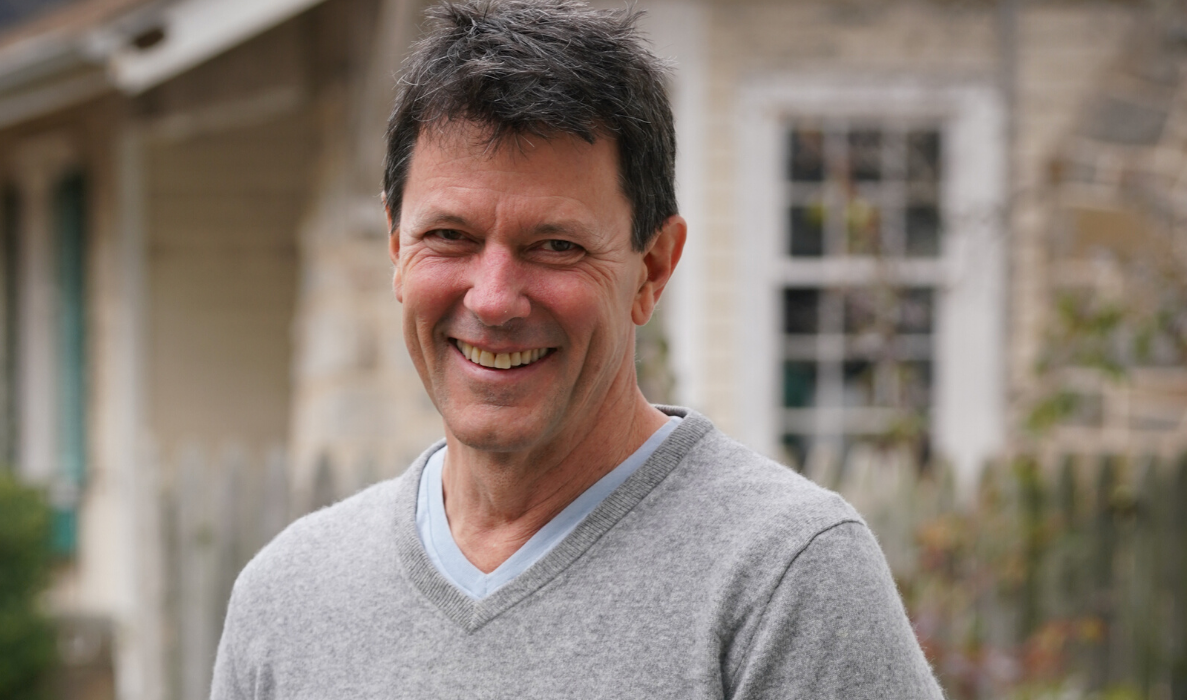The Spirituality of Silliness

Before the guests arrived at the wake, my brothers and I stood in front of the open casket of our brother Matt who had just died of AIDS at the age of 23. We looked on for a time in silence, then a brother on my left said, “Why do his hands look all screwed up?” And a brother on my right leaned in and whispered, “Because he’s dead!”
We exploded in laughter.
That moment of emotional blasphemy came at a time in my life when I was way too serious in my pursuit of spiritual gains and deeply in need of the balancing power of laughter. I remember back then getting a gift of a small statue of a fat-bellied Buddha laughing joyfully with his arms stretched over his head. I hated that Buddha. I wanted a perfectly-postured, cross-legged, unsmiling Buddha with great abs.
It took me more than 30 years to lighten up.
In 2018, inspired by a trio of teachers – Annie Hopper, Rick Hanson, and Richard Rohr — I gave up the mindfulness practice that encouraged me to “just observe,” and replaced it with an effort to, in Hanson’s words, “decrease what’s negative and increase what’s positive.” In his book The Universal Christ, Rohr cites Hanson and concurs, “The only way, then, to increase authentic spirituality is to deliberately practice actually enjoying a positive response and a grateful heart.”
It’s called “self-directed neuroplasticity,” and in terms of joy increased and suffering reduced for time invested and money spent, this is the best thing I’ve ever done. The transition wasn’t easy, though. As Rohr says, we have a “toxic attraction to the negative.” I can be buried in anger for an hour before I’m even aware I’m there, and once I see where I am, the addictive appeal keeps me from pulling away. Depression is even stickier.
So what’s the best way to climb out of a dark place when you’re not sure you really want to? A lot of approaches are possible—deep breathing, reciting a sacred word, turning to a favorite thought, doing a positive activity. But I’ve found that, for me, the most effective approach for switching off the negative and turning on the positive—is laughter.
For a time I wondered if laughter wasn’t just an act of denial, but grief counselor Ted Wiard—who lost his little brother in a boating accident, then his young wife to cancer, then his two little girls in a car accident—told me that laughter isn’t an effort to deny grief or bypass loss. “Laughter recognizes the loss,” he said, “but it expands the event to bring in hope to help the healing.”
So I began looking for ways to make myself laugh. I would find myself hating a situation, and whisper, “I am loving this!” and the statement alone would make me laugh. Sometimes I’d be in a black mood and say to myself, “Ha! Ha! Ha!” That worked too. Other times I would clap. A friend of mine said, “Clap?!” “Yes,” I said. “Clap my hands together like a small child.” Her response told me that I had crossed the border from funny to silly.
A few days later, I wrote to a friend, “I think one of the secrets is laughter, and a good way to get to laughter is being silly, and being silly is hard for people who are too attached to their dignity. Like me. But, wow, is it helpful.”
She wrote back, “Yes! That’s so novel! The danger of evil is that it consumes us, and makes us think that laughter, silliness, and love are irresponsible. Let’s turn that thinking on its head!”
That’s when I began to name the thing, and believe in the spiritual power of silliness. Now my approach for replacing the negative with the positive—during my daily practice or in the middle of the day when I’m feeling down—is to make myself laugh by being silly.
The good news is that I was born to be silly, and so were you. And there are little pockets of our lives where it’s still safe to be silly. When our dog, Walter, died at age four, we didn’t just miss him, we missed the way we were when we were with him. So after a pause, we adopted Chester and restored silliness to our home!
Little kids, too, give us permission to be silly. When I was a dad taking care of little boys, I was allowed to act like a little boy. (Yippeee!) The other day I was wedged in a crowded elevator when a three-year-old girl gave us an inspiring performance of “Itsy bitsy spider.” My mood lifted like a rocket, and I got off the elevator thinking, “Oh my God, I should have sung it with her. How did I miss that!?” Later in the day, when I was doing my practice all alone in my basement with no one else around, I sang “Itsy, bitsy spider” all by myself, including the cute hand gestures.
Which brings me to the biggest barrier to silliness–embarrassment.
I try to find the border where embarrassment begins, then cross it. I look for ways to embarrass myself, but only in front of myself. If there’s a theme in my practice, it’s imitating children, or myself as a child, or just doing make-believe. I have jumped up and down, clapped my hands, and shouted, “Cookies! Cookies! Hooray for Cookies!!” I have paraded around my basement to John Phillip Sousa marches. I have raised my right hand, placed my left hand on the Bible, and recited the oath of office of the President of the United States. (It’s only 35 words, and it’s wise to be ready. These are unpredictable times.)
My antics taught me something startling. When I do a new silly thing, I first feel a wave of shame, but if I stick with the silliness, the shame passes and I laugh out loud. I was surprised that I could feel shame when no one was watching. But then I thought, “Of course I feel shame when I let the outcast parts in; it’s shame that made me cast them out.”
In Brene Brown’s book Rising Strong, an editor quotes Nietzsche to her, “What is the seal of liberation? To no longer be ashamed in front of yourself.”
Silliness draws out shame in order to defeat it.
Silliness is rebellion. Silliness is being daring. Being defenseless. Being vulnerable. Silliness is dropping the mask. It’s an act of faith, a mark of trust—even when it’s only with yourself. But when silliness is shared, it’s intimacy. Magic. Some of the happiest moments in my childhood home came when my dad was being silly. It was a celebration. Once you feel the joy of being silly, it’s easy to share because it’s hard to hold in, like a happy child who starts to skip. (When’s the last time you skipped?)
None of this changes the fact that being silly can feel weird and undignified, and I’ve tried to argue my way out of it.
How can I be silly when people are suffering?
The question’s easier to answer than it sounds. Love is the only force that can heal the world, laughter is a gateway to love, and silliness is a short-cut to laughter.
I wish I had seen this sooner.
Life is too serious for us not to be silly.
Now everyone, repeat after me, “The itsy bitsy spider crawled up the water spout …”
This essay was featured in the January 19th edition of The Sunday Paper. The Sunday Paper inspires hearts and minds to rise above the noise. To get The Sunday Paper delivered to your inbox each Sunday morning for free, click here to subscribe.


